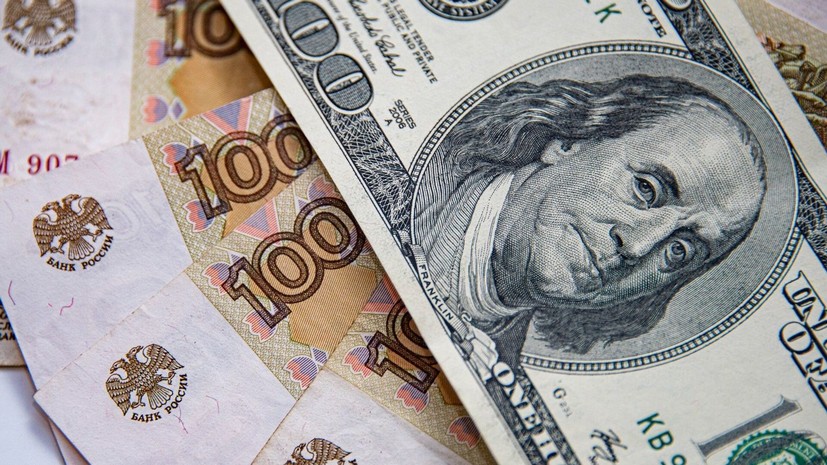On Thursday, January 12, the Russian currency is steadily rising in price on the Moscow Exchange.
During trading, the dollar fell by 1.8% to 67.5 rubles.
The last time a similar value could be observed was December 23, 2022.
At the same time, the euro exchange rate fell by 2.1% and for the first time since December 30 reached 72.44 rubles.
In turn, the value of the yuan fell by more than 1%, to 9.97 rubles - the lowest level since January 3.
The national currency is strengthening against the American, European and Chinese for the fourth day in a row.
One of the reasons for the observed dynamics was the actions of Russian exporting companies, BitRiver financial analyst Vladislav Antonov suggested in an interview with RT.
According to him, the business began to sell the foreign exchange earnings accumulated over the holidays in anticipation of the tax period.
At this time, enterprises traditionally exchange dollars, euros and yuan received from the export of their goods for rubles to pay taxes.
“Companies have been selling foreign currency since January 9th.
However, the volume of these sales will only increase as we approach the peak of tax payments, which will fall on January 25, ”added Antonov.
In addition, as the expert noted, the statements of the Russian authorities provided additional support to the ruble: investors reacted positively to the news about the restart of the fiscal rule mechanism in the country.
The day before, the Ministry of Finance and the Central Bank of Russia announced plans to resume operations in the domestic foreign exchange market.
From January 13 to February 6, the Central Bank plans to sell yuan daily from the National Welfare Fund (NWF).
In total, during this period, the regulator intends to exchange the Chinese currency in the equivalent of 54.5 billion rubles.
Gettyimages.ru
Recall that the budget rule is used to protect the economy and the ruble from fluctuations in oil prices.
If the cost of raw materials rises above the so-called cut-off price (now it is about $62-63 per barrel), then the state directs oil and gas excess profits (money received from the sale of oil is more expensive than the cut-off price) not for current budget spending, but for the purchase of foreign currency in the National Welfare Fund.
Thus, in the event of an increase in energy prices, the Ministry of Finance and the Central Bank acquire more currency for the NWF and thereby put artificial pressure on the ruble.
Meanwhile, when oil becomes cheaper and its value falls below the cut-off price, the authorities begin to sell foreign currency.
As a result, the demand for foreign banknotes is declining, and the ruble should be strengthening.
In the spring of 2022, the work of the budget rule was suspended due to Western sanctions, the blocking of almost half of Russia's gold and foreign exchange reserves, and the unprecedented collapse of the ruble.
At that moment, all the oil and gas revenues that would have previously gone to the NWF began to be spent on supporting the economy.
Later, as the situation in the country returned to normal, the authorities decided to renew the budget rule in 2023, but with some adjustments.
If earlier, within the framework of the initiative, the Ministry of Finance and the Central Bank carried out operations with dollars and euros, now, due to sanctions, these currencies were decided to be withdrawn from the structure of the NWF.
At the same time, the authorities agreed to double the share of yuan and gold in the structure of the fund, so now all interventions in the foreign exchange market will be carried out with Chinese banknotes.
“Buying or selling yuan under the fiscal rule should smooth out fluctuations in the ruble against the yuan in the short term.
With a high probability, the movement of the rates of other currencies against the Russian ruble will approximately - with an accuracy of a few percent - correspond to the dynamics of the ruble against the yuan, ”said Vasily Ivanov, managing director of Otkritie Management Company, in a conversation with RT.
Forecast range
It is curious, but initially market players expected that after the restart of the budget rule, the Central Bank would start buying yuan from the NWF.
This would play against the ruble.
However, today Russian Urals oil is sold cheaper than the cut-off price and costs about $50 per barrel.
As a result, according to the forecast of the Ministry of Finance, in January the country's budget will lose about 54.5 billion rubles of oil and gas revenues.
Against this background, the Central Bank will sell foreign currency from the NWF to compensate for the losses of the treasury.
“The direct impact on the exchange rate dynamics of the ruble from the restart of the budget rule is expected to be insignificant.
However, in the case when foreign currency is sold, it still supports the ruble.
Moreover, in February, after the entry into force of the European embargo on the import of petroleum products from Russia, according to our estimates, the volume of sales of yuan could double, ”said Alexander Bakhtin, an investment strategist at BCS World of Investments, to RT.
According to the expert, in the current conditions, by the end of winter, the dollar exchange rate may stabilize around 66-69 rubles.
At the same time, the euro exchange rate will probably fluctuate in the corridor of 70-74 rubles, and the yuan exchange rate will be around the 10 ruble mark or slightly lower.
At the same time, Vladislav Antonov does not rule out the possibility of rates moving in wider ranges.
According to the forecast of the specialist, in the next two months the cost of the American currency will vary from 67.5 to 75.5 rubles, the European - from 72 to 77 rubles, and the Chinese - from 9.95 to 10.45 rubles.

